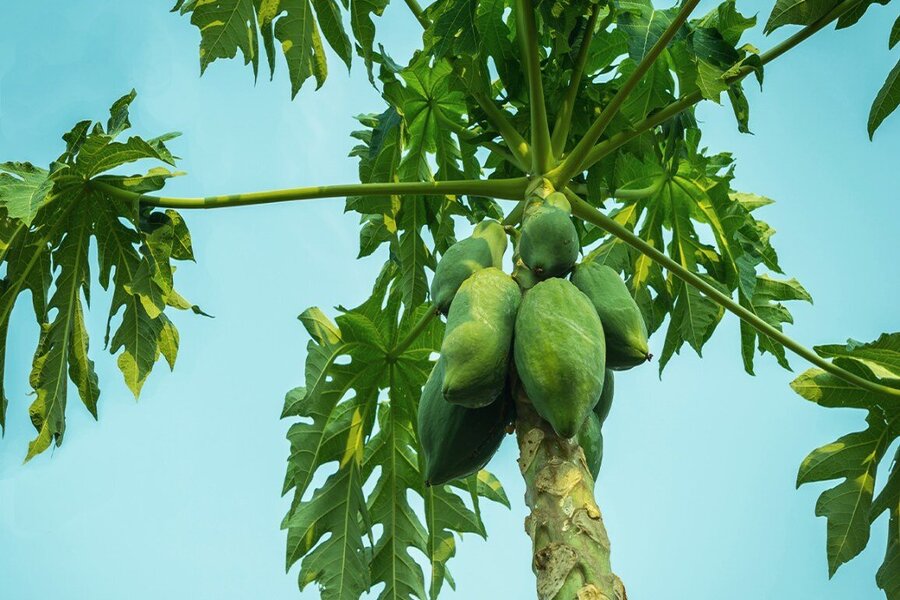Carica papaya is a fruit-bearing tree, native to Mexico and northern South America. Papaya is a frequently grown crop. Fruit, seeds, and leaves are used in cooking and folk medicine. Papaya leaf includes unique plant chemicals with therapeutic potential. Papaya leaf teas, extracts, pills, and juices are used to treat ailments and boost health, despite a paucity of human research.
Here are 7 new papaya leaf uses
1. Alleviates dengue fever symptoms
Papaya leaves can treat dengue fever symptoms. Dengue is a mosquito-borne virus that can be transmitted to people and causes flu-like symptoms. Severe cases can deplete blood platelets. Low platelet levels might cause deadly bleeding if left untreated. Papaya leaf is one of several remedies for dengue’s symptoms. Papaya leaf extracts dramatically enhanced blood platelet levels in three dengue investigations. Papaya leaf therapy has few side effects and was cheaper than traditional therapies.
2. Balances blood sugar
Mexican folk medicine uses papaya leaf to cure diabetes and manage blood sugar. Papaya leaf extract has anti-inflammatory and blood-sugar-lowering properties in diabetic rats. Papaya leaf protects insulin-producing pancreatic cells from injury and death. No evidence suggests humans will have the same impacts. Papaya leaf may help humans manage high blood sugar, but more research is needed.
3. Aids digestion
Papaya leaf teas and extracts are used to relieve gas, bloating, and heartburn. Papaya leaf includes fibre, which aids digestion, and papain. Papain breaks down big proteins into smaller, easier-to-digest ones. Culinary uses include meat tenderizers. An IBS study indicated that supplementing with papain powder from papaya fruit improved constipation and heartburn. No research has tested papaya leaf’s ability to cure digestive disorders. Most evidence encouraging its usage for this purpose is anecdotal, and there’s no certainty it’ll help digestive function.
4. Anti-inflammatory
Papaya leaf formulations are used to treat rashes, muscle pains, and joint pain. Papaya leaf includes anti-inflammatory papain, flavonoids, and vitamin E. Papaya leaf extracts decreased inflammation and oedema in arthritis-stricken rats’ paws. Human investigations haven’t confirmed these findings. Insufficient information exists to evaluate if papaya leaf can cure acute or chronic inflammation in humans.
5. Hair growth-supporting
Papaya leaf masks and juices are used to stimulate hair growth and scalp health, however, data are lacking. High oxidative stress may cause hair loss, according to some research. Antioxidant-rich meals may reduce oxidative stress and boost hair development. Papaya leaf contains flavonoids and vitamin E. Advocates of papaya leaf for hair development claim its antioxidant content. There’s no evidence that papaya leaves can boost hair growth. Malassezia overgrowth can inhibit hair growth and produce dandruff. Papaya leaf contains antifungal characteristics; therefore it may improve hair and scalp health by suppressing dandruff-causing fungus. Papaya leaf hasn’t been tested against Malassezia, thus are no guarantees.
6. Healthy skin
Papaya leaf is eaten or applied topically to retain soft, clear, youthful skin. Papain can be used topically as an exfoliator to exfoliate dead skin cells and alleviate clogged pores, ingrown hairs, and acne. Papaya leaf enzymes accelerate wound healing and reduce scarring in rabbits, according to a study.
Anticancer properties – Traditional medicine uses papaya leaf to prevent and treat cancer, but modern research is limited. Papaya leaf extract inhibits prostate and breast cancer cell growth in test tubes, but animal and human research has not duplicated these results. Papaya leaves and other antioxidant-rich foods may prevent cancer, but they aren’t cures.

